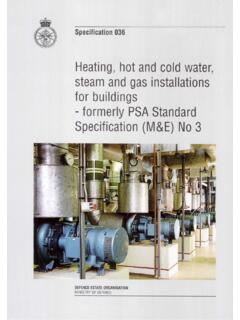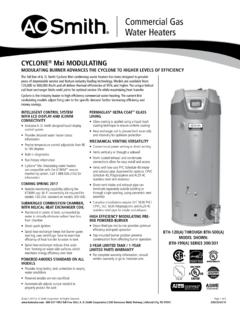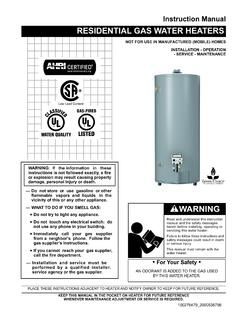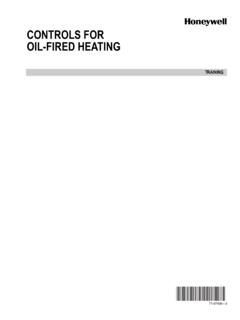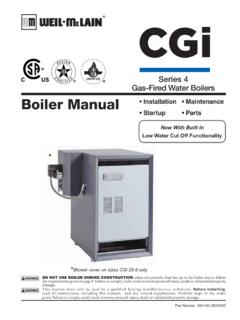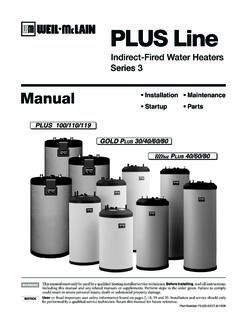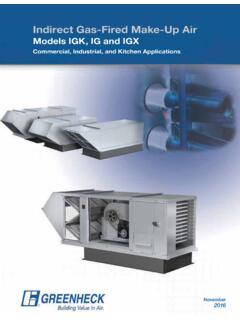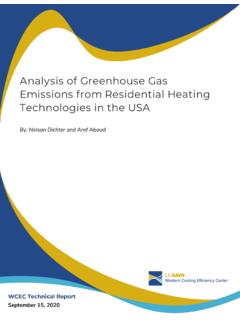Transcription of DOMESTIC HOT AND COLD WATER SUPPLY AND CENTRAL …
1 DOMESTICHOT AND cold WATER SUPPLY AND CENTRAL heating SYSTEMSG uidance NotesIntroduction Plastic pipes are widely used in DOMESTIC hot and cold WATER SUPPLY and CENTRAL heating systems. Their flexibility offers the benefits of easy handling and installation. They are available in both straight lengths and coils, which enables threading around obstructions and through joists, reducing the number of joints required and the potential for leaks. Where joints are required, the extensive range of fittings available for each pipe system enables reliable, watertight joints to be made quickly and guide provides information on materials, service conditions, design and installation of plastic pipes primarily for DOMESTIC hot and cold WATER systems and CENTRAL heating systems for residential properties (excluding patient accommodation).
2 OverviewSYSTEMS02 cold WATER SUPPLY pipework carrying WATER for DOMESTIC purposes including drinking, washing and operation of sanitary appliances. Hot WATER SUPPLY pipework carrying heated WATER for DOMESTIC purposes including washing. This guide excludes continuously circulated hot WATER systems, see note 1 below. CENTRAL heating systems pipework carrying heated WATER for space heating , see note 2 1: These systems (known as recirculating, secondary hot circulation, return or ring main systems) carry pumped hot WATER to outlets where the temperature is typically above 60 C (maximum 70 C) and is replenished by an incoming WATER SUPPLY to replace the WATER drawn to outlets.
3 These systems are very different from intermittent systems for hot WATER distribution which are only hot when WATER is being drawn. Only products approved by the manufacturer for continuously operating systems should be used. The manufacturer and their technical information must always be consulted for specific limitations. A clear understanding of the quality of the WATER to be used in a recirculating system is essential. The long-term performance of a continuously operating system will be affected by the temperature and pressure duty cycle and the aggressiveness of the WATER from free chlorine and pH. Disinfection routines may also have an effect and therefore must also be agreed by the 2: Guidance on use of plastic pipes for warm WATER underfloor heating systems is available from the BPF Pipes Group at AND cold WATER SUPPLY AND CENTRAL heating SYSTEMSPIPESFor hot and cold WATER SUPPLY and heating systems, the most suitable pipes are solid wall polybutylene (PB, also known as Polybutene, Polybut-1-ene and Polybutene-1) or cross-linked polyethylene (PEX); barrier pipes (plastic inner and outer wall with an adhesively bonded intermediate layer of plastic that forms a barrier to the passage of oxygen).
4 And multi-layer pipes (MLC, plastic inner and outer wall with a bonded intermediate layer of metal such as aluminium). In this guide, the term plastic pipes is used to cover all of these pipes, unless otherwise are generally available in nominal diameters of 10mm to 110mm in straight lengths or : other materials may be offered for specific applications such as ABS and PVC-U ( cold WATER SUPPLY ), C-PVC and PP-R (hot and cold WATER SUPPLY ). Guidance should be sought from the manufacturer on application and ensure the jointing system is compatible with the pipe being installed, the relevant manufacturer s literature should be consulted. The most common jointing system for DOMESTIC applications is a push-fit fitting.
5 A support sleeve is inserted into the pipe end and the pipe pushed firmly into the fitting to an insertion mark or specified depth. Push fit joints incorporate a rubber seal and a gripping mechanism to provide a secure mechanical connection. They are generally demountable either by unscrewing or by using a special systems include: Mechanical compression jointing - the fitting compresses the pipe when mechanically tightened by the installer. These fittings may be supplied with / without a seal depending on design. Special tools may be required and a support sleeve would usually be required. Press fit jointing the fitting comprises a metal outer sleeve and plastic or metal body with integral inserts.
6 Using a special power tool, the outer sleeve is pressed to grip the pipe to the fitting body. Socket fusion the outside of the pipe and the inside of the fitting are heated to a sufficient temperature. The two parts are then quickly pushed together, held for a determined length of time and, in cooling, the two parts combine to create a joint. Butt fusion - the parts to be jointed are pressed against a heating element and a bead is formed. The parts are then brought together and held under pressure. Pressure is also maintained during the cooling time. After jointing a bead should have formed around the whole circumference. Electrofusion - In this method the pipe and special fittings are heated by means of electrical resistance and fused together.
7 The power and heating time is supplied through an electrofusion control unit. Shrink-fit - once a support ring is added to the end of the tube, either a hand operated or an electric expansion tool is used to swage open the pipe to allow the fitting to be inserted. The elastic memory of the pipe shrinks back onto the fitting making the permanent watertight also offer their own innovative designs and range of accessories such as pipe-in-conduit, pre-insulated pipes, pipes clips spacers, cold forming bends, pipe cutters etc. The manufacturer s literature should be consulted for the full range of fittings and accessories available for each HOT AND cold WATER SUPPLY AND CENTRAL heating SYSTEMSADVANTAGESThe market s transition to plastic pipes for these applications has been driven by the practical advantages over traditional materials.
8 In-service: smooth internal bore reduces the accumulation of limescale and improves flow through the pipes reducing energy requirements; low thermal conductivity means that pipes carrying hot WATER are cooler and therefore safer to the touch; inherent corrosion resistance maintains a clean SUPPLY ; and low noise transmission means that noise from the pumping systems are not broadcast through the building. Installation: lightweight, long lengths supplied in coils reduces the number of joints saving time and reducing the risk of leaks; flexibility means pipes can easily navigate obstructions; wide range of fittings which permit connection to existing metal pipework and avoids the use of solder or naked flames.
9 Physical: inherent properties combined with well-chosen joints allow thermal expansion during heating / cooling to be accommodated and reduces the risk of bursts during frosts; impact resistance means pipes are not easily damaged during installation or service; low scrap value reduces risk of theft from HOT AND cold WATER SUPPLY AND CENTRAL heating SYSTEMS05 DOMESTIC HOT AND cold WATER SUPPLY AND CENTRAL heating SYSTEMSUK SERVICE CONDITIONSThe service conditions in UK WATER SUPPLY and heating applications during routine operation and system malfunction are shown in the table pipes and fittings assessed against all of these service conditions (designated as Class S to Table 1, BS 7291-1: 2010) can be safely used in UK applications, in particular the higher temperatures and pressures associated with unvented hot WATER storage systems and sealed CENTRAL heating .
10 Guidance on use of plastic pipes for discharge from unvented heating systems is available from the BPF Pipes Group Plastic pipes are not suitable for boiler vent pipes. Nominal System FlowTemperature (Tf)MaximumSystem ServiceTemperature (Ts)SystemMalfunctionTemperature (Tm)SystemMaximumWorking PressureIndirect cold WATER mains-fed cold WATER heating hot WATER hot WATER systems including instantaneous heaters and/or incorporating storage (excluding continuously operated systems)65951006 Vented CENTRAL heating systems and indirect hot WATER primary CENTRAL heating systems and indirect hot WATER primary circuits821051143 DesignConventional design methods for hot and cold WATER SUPPLY and heating systems still apply when using plastic pipes.




